

Leonardo da Vinci Homeschool Unit Study. This Leonardo da Vinci homeschool unit study will give both of you a chance to learn a lot while having fun.

We gathered together some awesome resources and there is plenty to explore including activities, books, art, and game. Leonardo da Vinci is someone who is so very interesting to study. He was, indeed, a Renaissance man. He was into everything from paintings (The Mona Lisa, The Last Supper) to machines (helicopter, armored war machines.)
He created flying machines, bridges, maps, and so much more. His designs have been used to create many modern items. Use this Leonardo da Vinci Homeschool Unit Study to discover interesting information and to have fun learning about Leonardo da Vinci. Special thanks to Wikimedia Commons for use of the images in the collages. We have included quotes from Leonardo da Vinci in this article–I hope you and your boy like them. Easy Tie Dye Art with Baby Wipes. Once I became a mom, I found that there are a million ways to use baby wipes that have nothing to do with wiping bottoms. :) We recently discovered that baby wipes can be great for art!
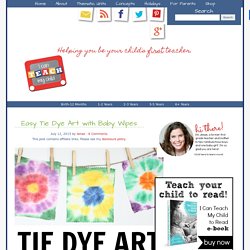
We used them to make some SUPER easy tie dye art with baby wipes that can easily be done with kids of all ages. No need to worry about stains and permanently dyed fingers…everything is completely washable! We especially love Huggies Wipes from Walmart for this project! Huggies Triple Clean layers are thick and hold up much better than other wipes we’ve tried. Here’s what you’ll need: Wolf Art for Kids. Use Your Coloured Pencils: Still Life Vases. Spring in Australia brings an abundance of our floral emblem, the Golden Wattle.
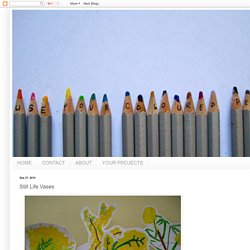
My grade threes attempted still life drawing for the first time with jars of wattle cut from trees around the school. We used lead pencils and green and brown textas to draw the jars, stems and leaves onto white card. They then dabbed on yellow tempera paint with a small brush to try to create the fluffy texture of the flower. When complete, we carefully cut out the drawings and glued a heavy cardboard stand to the back to make our vases stand atop the bookcases. This project was inspired by the similar drawings of mimosa at Manuales. Forwards & Backwards: Mirror-Image Geometry. Monet Craft for Kids. Exploring Monet with Preschoolers. The Dot Song LIVE - Emily Arrow & Peter H. Reynolds. Easy Art For Kids - Experimenting with Water Colours. Make a Paper Doll's House - Free Printable - Picklebums. Paper Bag Crowns - Art Bar. I love the way these crowns turned out.

Science for Kids: Balancing Robot (FREE Printable) Here’s a super fun science activity that really gets kids thinking!
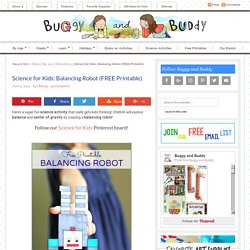
Children will explore balance and center of gravity by creating a balancing robot! Follow our Science for Kids Pinterest board! *This activity was originally published on June 1, 2014 and has since been updated. This balancing robot science exploration has always been a huge favorite among my students! In this science activity kids will place two pennies in various locations on a paper robot until they’ve discovered how to make the robot balance. Rolled Paper Sculptures - Art Bar. My four-year old art students never cease to amaze me.
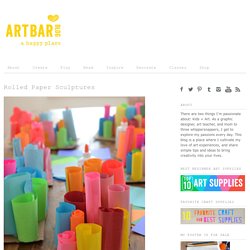
Each week I spend a LOT of time thinking up projects for class. Lotta%20palette.pdf. Scrumdilly-do!: Self Portrait-Literal Cubism. While not necessarily done in the style of Picasso, this project is a fun exploration of shapes and squares.
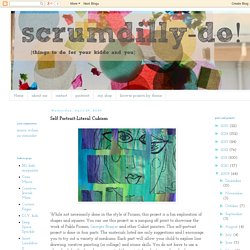
You can use this project as a jumping off point to showcase the work of Pablo Picasso, Georges Braque and other Cubist painters. This self-portrait project is done in four parts. The materials listed are only suggestions and I encourage you to try out a variety of mediums. Each part will allow your child to explore line drawing, creative painting (or collage) and scissor skills. You do not have to use a phonebook for the line drawing part of the project. What you need:recycled phonebook pages (white pages work best)paint of your choiceGlue or adhesive of your choicescissorspaintbrushes or spongebrushesfat black markerlarge sheets of sturdy white paper (11” by 17” is good) scrumdilly-do it: For the first part, have your kidlet cover their large sheet of white paper in up to four colors of their choice.
While that dries, paint your phonebook page all over. Tippytoe Crafts: famous artists. This week we are studying famous artists.
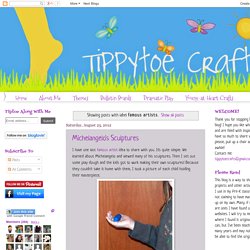
Yesterday we talked about Claude Monet. I showed the kids several of his lily pond paintings and then we recreated one of his paintings with the bridge. I was just planning on having the kids paint the bridge along with everything else, but then as I was searching for other ideas, I saw how they used tape for the bridge at The Crafty Classroom. Genius! So first I made bridges on the paper using masking tape.
Then I set out the paint. The kids used a dabbing technique to paint their pictures. How to Make Fireworks in a Glass ~ so tomorrow. Art Storytime ~ so tomorrow. My theme last week at storytime was art.
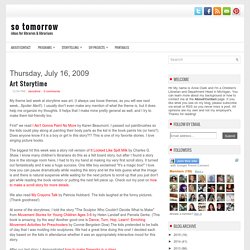
(I always use loose themes, as you will see next week...Spoiler Alert!). I usually don't even make any mention of what the theme is, but it does help me organize my thoughts. Amazon. Amazon. Art Storytime : Sturdy for Common Things. Little Picasso: 10 Best Art Apps for Kids. If you own a tablet or smartphone, chances are you love the easy-to-use interface for browsing the web or playing games, but what about creating artwork?
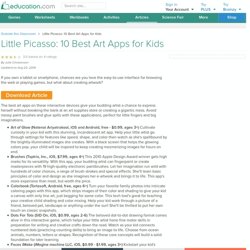
The best art apps on these interactive devices give your budding artist a chance to express herself without breaking the bank at an art supplies store or creating a gigantic mess. Avoid messy paint brushes and glue spills with these applications, perfect for little fingers and big imaginations. Art of Glow (Natenai Ariyatrakool, iOS and Android, free - $0.99, ages 3+) Cultivate curiosity in your kid with this stunning, incandescent art app. Help your little artist go through settings for features like speed, shape, and color then watch as she's spellbound by the brightly-illuminated images she creates.
With a black screen that helps the glowing colors pop, your child will be inspired to keep creating mezmerizing images for hours on end. Artist Inspired Art Projects for Kids. 15 Fine Art Projects for Kids. Fine Art Activities. Amazon. 21 Picture Books About Art. Lukes-Way-of-Looking. BookWorms on 612ABC Brisbane - Children's Books Daily... The idea of making, tinkering, engineering and creating is not a new one – in fact it is as old as time itself. Most individuals and communities have an innate desire to tinker and invent and better the way things in their environments function. Many young people are natural tinkerers and creators – first with blocks and paddlepop sticks, later with home electrics that you didn’t want taken apart.
However, as society has turned more and more to technology to find solutions and to improve the quality of our lives and our experiences, less time is spent questioning, inquiring and fixing and even less time is spent making mistakes and refining skills through trying, failing and trying again. Makerspaces are the perfect partnership for libraries – where information is stored, accessed, shared, explored and wondered over.
Picasso Portraits - Kindergarten Style! Picasso gives us many great opportunities to teach about abstract art! I like to do this lesson with my Kinders after I teach them the more “traditional” methods of drawing portraits. They really enjoy this chance to “get a little crazy” with their art! (Warning: Get ready to hear some of the FUNNIEST comments from 5 and 6 year olds while doing this project.… My favorite was from a little boy who very seriously said, “Hmmm…This kind of looks like my dad.”) Begin by showing students some examples of Picasso’s work in the various different styles he worked in. Talk about realistic vs. abstract art.